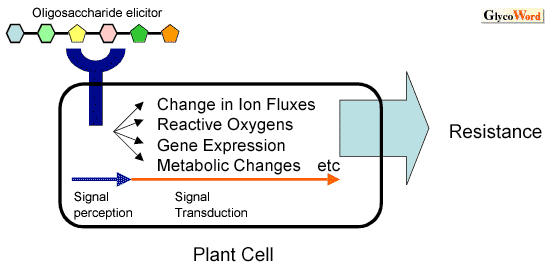|
Oligosaccharide Elicitors as Crop Protectants
|
|
|
 |
Upon infection, higher plants evoke a set of defense responses, which specific substances, called elicitors, can mimic. Fragments of galacturonic acid, chitin, glucan and others are known to carry elicitor activity. The perception and signaling mechanisms of oligosaccharide elicitors are one of the central research areas in plant science and has been reviewed (Signal Transduction and Gene Expression Induced by Oligosaccharides in Plants). Host resistance against pathogens is accompanied by a variety of biochemical, physiological and genetical changes such as ion fluxes, production of reactive oxygen species, gene expression and metabolic variations (Figure 1). Oligosaccharide elicitors are powerful tools for analyzing each component of the signal networks that lead to the establishment of host resistance. Recently, several studies have indicated that oligosaccharide elicitors may be an inducer of resistance in host plants against pathogen attack. |
|
|
|
|

| Figure 1 Defense
responses induced by elicitor |
| |
| |
|
|
|
|
|
Laminarin, a storage polysaccharide of the marine brown algae, Laminaria digitata, is a hydrophilic  -1,3-glucan with branching structure at low frequency. Laminarin (average DP=33) showed elicitor activity in suspension-cultured tobacco cells, inducing a transient alkalinization of the medium, production of reactive oxygens, activation of two defense-related enzymes, phenylalanine ammonia-lyase and lipooxygenase, accumulation of salicylic acid, and pathogenesis-related proteins such as chitinase and -1,3-glucan with branching structure at low frequency. Laminarin (average DP=33) showed elicitor activity in suspension-cultured tobacco cells, inducing a transient alkalinization of the medium, production of reactive oxygens, activation of two defense-related enzymes, phenylalanine ammonia-lyase and lipooxygenase, accumulation of salicylic acid, and pathogenesis-related proteins such as chitinase and  -1,3-glucanase. Tobacco plants treated with laminarin showed significant resistance against pathogenic bacteria, Erwinia carotovora, a causal agent of soft rot disease 1). Laminarin similarly induced defense responses in suspension-cultured grapevine cells such as uptake of Ca2+ and H+, production of reactive oxygens, activation of defense-related genes and accumulation of two phytoalexins, resveratrol and viniferin. Spraying of laminarin conferred resistance to grapevine plants against pathogenic fungi, Plasmopara viticola, a causal agent of powdery mildew disease2). Oligomer of sulfated fucan, a common component of cell wall of marine brown algae, was also shown to induce similar defense responses in tobacco and resistance against infection by tobacco mosaic virus3). In these studies, oligosaccharides induced resistance without cell death. -1,3-glucanase. Tobacco plants treated with laminarin showed significant resistance against pathogenic bacteria, Erwinia carotovora, a causal agent of soft rot disease 1). Laminarin similarly induced defense responses in suspension-cultured grapevine cells such as uptake of Ca2+ and H+, production of reactive oxygens, activation of defense-related genes and accumulation of two phytoalexins, resveratrol and viniferin. Spraying of laminarin conferred resistance to grapevine plants against pathogenic fungi, Plasmopara viticola, a causal agent of powdery mildew disease2). Oligomer of sulfated fucan, a common component of cell wall of marine brown algae, was also shown to induce similar defense responses in tobacco and resistance against infection by tobacco mosaic virus3). In these studies, oligosaccharides induced resistance without cell death.
Most practical fungicides kill or suppress the growth of pathogens and often confer resistance to the reagents. Therefore, inducing resistance is more desirable because the frequency of appearance of resistant pathogens is expected to be much lower. However, few such reagents are available, e.g., probenazol, a blast-control reagent. In this context, oligosaccharide elicitors may be good candidates for a new type of farm chemical for disease control. They are natural products and recyclable in the ecosystem. |
|
|
|
Eiichi Minami (Department of Biotechnology, National Institute of Agrobiological Resources) |
|
|
|
|
|
| References |
(1) |
Klarzynski O, Plesse B, Joubert JM, Vvin JC, Kopp M, Kloareg B, Fritig B: Liner beta- 1,3 glucans are elicitors of defense responses in tobacco. Plant Physiology, 124, 1027-1038, 2000 |
|
(2) |
Aziz A, Poinssot B, Daire X, Adrian M, Bezier A, Lambert B, Joubert JM, Pugin A: Laminarin elicits defense responses in grapevine and induces protection against Botrytis cinerea and Plasmopara viticola. Molecular Plant-Microbe Interactions, 16, 1118-1128, 2003 |
|
|
(3) |
Klarzynski O, Descamps V, Plesse B, Yvin JC, Kloareg B, Fritig B: Sulfated fucan oligosaccharides elicit defense responses in tobacco and local and systemic resistance against tobacco mosaic virus. Molecular Plant-Microbe Interactions, 16, 115-122, 2003 |
|
|
|
|
|
| Nov. 30, 2004 |
|
|
|
|
|
|
|





